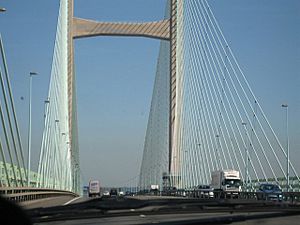Cable-stayed bridge facts for kids
A cable-stayed bridge is a bridge that has one or more columns (called towers or pylons), with cables directly supporting the bridge deck.
There are two main types of cable-stayed bridges. In the harp design, the cables are nearly parallel. This is done by attaching them to various points on the tower(s). The height of attachment of each cable on the tower is similar to the distance from the tower along the roadway to its lower attachment. In a fan design, the cables all connect to or pass over the top of the tower(s).
Compared to other bridge types, the cable-stayed is best for longer spans than used for cantilever bridges, and shorter than those needing a suspension bridge. Cantilever spans become too heavy if they were made longer. A cable-stay bridge is cheaper to build than a suspension bridge over a short distance.
Disadvantages of a Cable Stayed Bridge
- Sways in the wind
- Support is in water rather than sides
Advantages of a Cable Stayed Bridge
- Good stiffness
- Large ground anchorages are not required
- It is a modern looking bridge
- Economical for construction
- Well-balanced
- Difference between types of bridges
Images for kids
-
Øresund Bridge from Malmö to Copenhagen in Sweden and Denmark
-
Chain-stayed bridge by the Renaissance polymath Fausto Veranzio, from 1595/1616. Prior to industrial manufacture of heavy wire rope (steel cable), suspended or stayed bridges were firstly constructed with linked rods (chain).
-
Prins Clausbrug across the Amsterdam-Rhine Canal in Utrecht
-
Puente de la Unidad, joining San Pedro Garza García and Monterrey, a Cantilever spar cable-stayed bridge
-
Zhivopisny Bridge in Moscow is a multiple-span design.
-
Erasmus Bridge, Erasmusbrug, in Rotterdam, Netherlands
-
Margaret Hunt Hill Bridge over the Trinity River in Dallas, Texas, U.S. (2012)
-
Rio Negro Bridge, at 3,595 metres (11,795 ft), is the longest cable-stayed bridge in Brazil.
See also
 In Spanish: Puente atirantado para niños
In Spanish: Puente atirantado para niños














